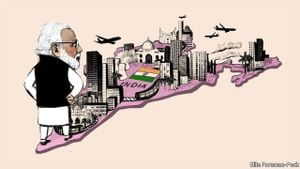China’s foreign policy has been vulnerable to changes, particularly as global dynamics evolve. The relationship between China, Iran, and Russia is raising eyebrows due to the disparate natures of these three regimes. Observers often wonder, what brings together such different countries, aside from the commonality of authoritarianism?
Many scholars note how these nations, including China, Iran, and Russia, stand out as the last of the truly great land empires. They seem to share some underlying unity: the quest for power on the geopolitical stage, positioned against what they perceive as Western hegemony. This inquiry leads to broader questions about their alliances and future positions on the international front.
China’s assertiveness on the global stage has spurred shifts not only in its relationships with countries like Iran and Russia but also with various neighboring nations, including India. For example, the long-standing border dispute between India and China has been renewed, particularly since 2020. After violent confrontations, India and China have taken strides toward improving relations, evidenced by their recent commitment to de-escalation along the Line of Actual Control. Prime Minister Modi and President Xi have emphasized the importance of rapport to enable economic cooperation, yet the underlying tensions remain.
Despite the warmth reflected at summits, experts assert the new deal does not signal any definitive shift. For India, bordering security ties with the United States have gradually strengthened, even as relations with China seem to flicker between tension and occasional thawing. The U.S. remains vigilant, considering these intricacies and the potential ramifications for its own strategic interests.
Recent interactions between India and China saw troop reductions along contested areas. News reports confirm substantial progress was made, with both sides dismantling temporary structures, and this groundwork is seen as the first step toward reduced tensions. Still, many realize this is only the tip of the iceberg.
A positive sign has arisen from Modi’s administration, which perceives these moves as steps back from what many describe as excessive military posturing. Indeed, the latest agreement on troop disengagement could restore some access for India's patrols, which was lost after China’s military incursions. With nearly 50,000 Indian troops deployed post-2020, another layer of complexity has emerged within this highly strategic theater.
The broader international community keeps watch, as both India and the U.S. benefit from stable ties. Despite tensions at the border, both nations, already entrenched economically and militarily, seek new avenues for cooperation, especially concerning trade.
Looking at the broader picture, the interconnectedness of global politics cannot be ignored. The intertwining of China, Iran, and Russia pushes observers to rethink their views on power structures and their longstanding competition with the U.S. While they may rebel against Western influence, each state simultaneously fosters relationships built on shared interests and strategies. This alliance raised hopes and alarms, prompting security concerns as the world braces for potential shifts.
The present situation narrates more than mere regional disputes; it highlights how nations adapt and thrive amid change. With the U.S. adopting more outspoken policies, the entire dynamic can only evolve. The foundation laid by recent agreements may lead to fluctuated perceptions of strength internationally, yet predictability remains elusive.
Examining these relationships from the ground level presents various layers, including military, economic, and strategic aspects. Analyzing this trio from the lens of geography unravels added dimensions, particularly underlining their discussions around cyberwarfare and online governance — arenas where they have demonstrated collaboration.
Indeed, today’s autocracies have adopted advanced technological defenses to manipulate information and safeguard power. Consequently, the idea of 'hybrid war' emerges, echoing ancient tactics redefined for the 21st century. The three nations also wield significant space under the banner of state control over the internet, fostering unified tactics against external threats.
Though analyzing their political cooperation reveals stark ideological contrasts — totalitarianism versus clerical leadership — their pursuit of control showcases common ground. Are they using their ecological, geographical, and technological resources to boost resilience against perceived threats? Consequently, prospects of sustained collaboration lead to mixed interpretations. Nevertheless, awareness persists within Western circles as they adapt policies concerning these rivals.
Taking Russia, for example, the Kremlin’s relationship with Tehran strengthens via arms trade within the confines of war. The increased supply of drones for Moscow’s aims showcases the logistical support Iran provides amid geopolitical standoffs. This shakeup brings back memories of Cold War tactics but skews toward contemporary Collaboration. The U.S. faces questions about its pivot involving India, as the layered interests reflect deep-rooted strategies on the international chessboard.
Several layers warrant attention: Balancing energy demands, military prowess, and geopolitical interests remain at the forefront of China’s, Iran’s, and Russia’s deliberations. Conversely, as the ties between New Delhi and Washington strengthen, opportunities for India’s economic growth emerge amid uncertain relations with its powerful neighbor, China. Can Modi transform obstacles to leverage? Only time will tell as nuances shift, and positions reshape across the global forefront.
Bearing witness to these developments encapsulates the essence of international relations. They remind us how alliances evolve amid national interests, outlining the complex interaction between powerful nations as they seek to expand influence and navigate potential shifts accordingly. With logistics responding dynamically to confrontations, diplomacy remains stronger behind traditional diplomacy and state interests, weaving competing narratives of power, authority, and revolution.
Attention to how alliances like China, Iran, and Russia behave under pressure compels all observers to question if their strategic insurance aligns with potential global forecasts or merely leads toward challenged territories. Will these rivalries lock nations within their own spheres effectively or will they spark engagement outside traditional boundaries?
When reshaping geopolitical interests proceeds alongside ascendant tensions, observers are justified to remain wary, poised to gauge future developments as they emerge. The intertwining of these complex relationships, coupled with regional ambitions, opens the stage for reflection on the factors, both old and new, beneath the shifting sands of global politics.



